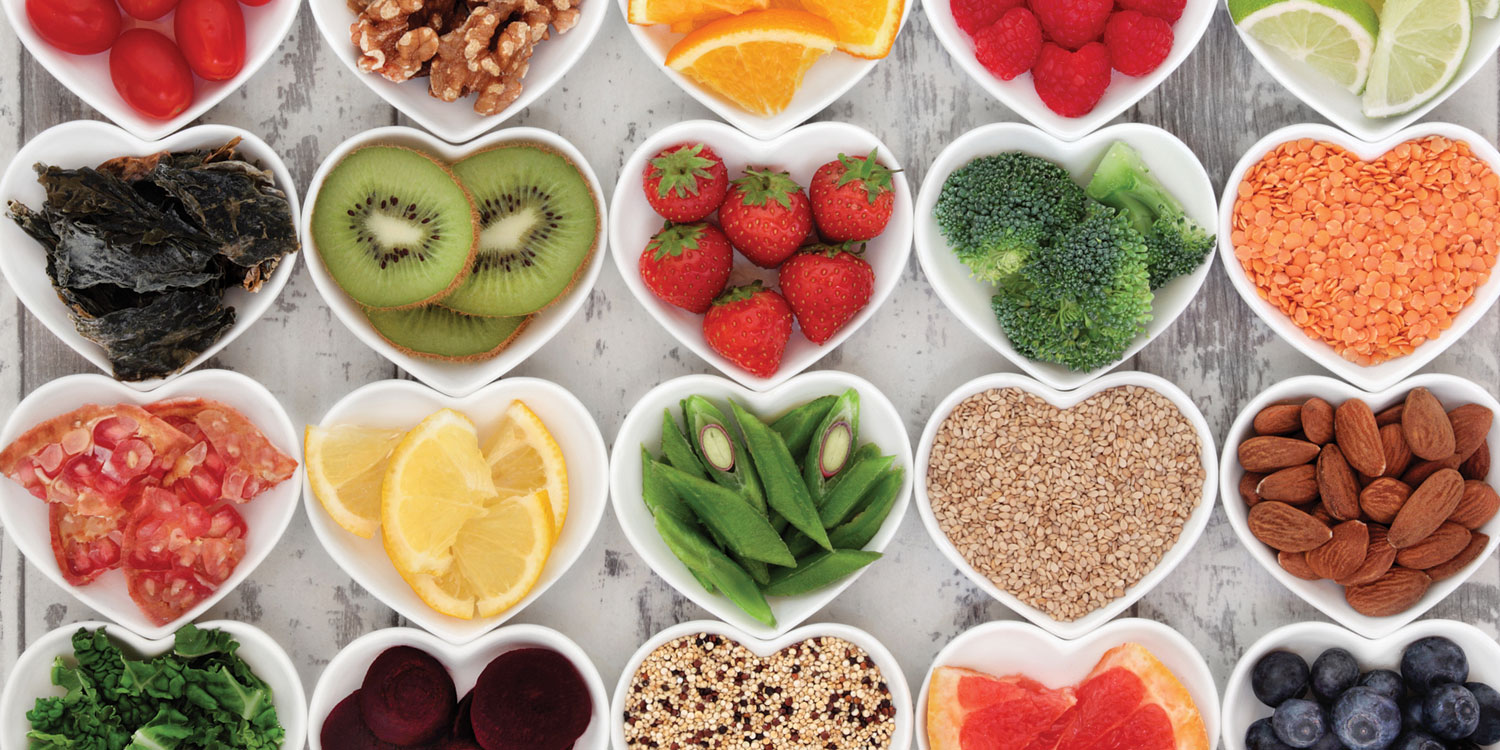7 Steps to a Trim New You
Fed up with gimmick diets with over-the-top promises? Or programs that deny you so many things that forbidden foods are all you think about?
It’s time to kick dieting to the curb. To find and maintain lifelong healthy weight, embrace lifestyle changes. Here are seven to start with.
1. Address your body’s many cries for nutrients.
You may think you’re craving a chocolate-covered doughnut, but in reality, your body really wants vitamins, minerals, phytonutrients, essential amino acids, essential fats, lean protein, and, of course, carbs for energy. You simply misinterpreted the signal! To minimize cravings, create a multicolored menu with a variety of fruits, vegetables, nuts, and seeds. Make it a goal to eat 7 to 10 servings of fruits and vegetables daily, and see how much room you have for anything else! Cravings will diminish when your body is getting the nutrients it needs for optimal health.
Supplemental support:
To round out your craving-crushing menu, start the day with a greens drink containing nutrients you won’t likely eat otherwise. Barley, alfalfa, wheatgrass, and red beets are great sources of chlorophyll. Greens drinks and supplements give you the nourishing benefits of sea veggies like spirulina, chlorella, and Atlantic dulse without having to put them on your plate! Look for green beverages or mixes containing antioxidant powerhouses like acerola cherries, bilberry, and grape extracts. Research also supports the use of chromium picolinate to reduce cravings.
2. Balance your blood sugar—and the scale.
A second major stumbling block with fat-loss plans is caused by blood sugar fluctuations that have your energy bottoming out several times a day—leading you straight to the snack machine. Focus on stabilizing your blood sugar by eating some protein with every meal and snack, starting with breakfast. Protein not only keeps the munchies at bay, but also helps to build lean muscle. Adequate dietary fiber helps to slow the release of glucose into the bloodstream.
Supplemental support:
To set yourself up for a balanced day, toss some whey protein isolate powder into a smoothie, along with berries, banana, or your favorite fruits. For fiber, glucomannan from konjac root is a water-soluble polysaccharide that helps to provide a feeling of fullness so you aren’t as inclined to snack. Glucomannan also slows the release of glucose into the bloodstream to help prevent energy highs and lows.
3. Rein in emotional eating.
It’s my observation that 98 percent of us have emotional connections to food, and the other 2 percent aren’t telling the truth! To put an end to sabotaging behavior, determine your emotional triggers and substitute a non-food comfort—like journaling, exercising, or talking with a friend. Emotional eating can become a serious issue in the wintertime, when reduced sun exposure leads to lower levels of the feel-good hormone serotonin. Likewise, a woman’s menstrual cycle can trigger fluctuating serotonin levels. Because carbohydrate consumption naturally stimulates serotonin production, it’s no wonder we reach for cookies or French fries. Support healthy serotonin production by eating foods containing vitamin B6 and the serotonin precursor tryptophan: whole grains, oatmeal, brown rice, and turkey are good foods to include.
Supplemental support:
Consider supplementing with precursor 5-Hydroxytryptophan (5-HTP) to help boost serotonin levels. Keep your digestive tract healthy with daily probiotic supplements: We’re starting to learn more about the gut/brain/mood connection. Healthy serotonin levels are closely linked to a strong digestive tract.
4. Burn, baby, burn!
We all know the simple equation that leads to fat loss: more calories out than calories in. Aim to exercise several times per week, and be sure to include muscle-building, weight-bearing activity.
Supplemental support:
Some foods are thermogenic, meaning they help kick your metabolic rate into high gear so you burn more calories. Look for supplements containing epigallocatechin-3-gallate (EGCG) from green tea or capsaicin from hot peppers to boost your burn. Conjugated linoleic acid (CLA) also helps support fat-loss goals, possibly by helping to suppress appetite and increase energy output.
5. Eat fat to burn fat.
Your body requires fat to create the membranes for every cell in your body, and your brain relies on good fats too. While we want to limit saturated fats and avoid trans fats, skipping dietary fat altogether is the best way to get your body to hold onto it. If you’d like to lose the love handles, choose fats that boost metabolism.
Supplemental support:
Long-chain polyunsaturated omega-3 fats EPA and DHA from fish oil may protect against the development of obesity, and they can help to reduce body fat in those who are already overweight. Be sure to take daily fish oil (or marine algae) supplements.
6. Seek balance to soothe the savage muffin top.
Weight gain around the middle is frequently caused by imbalanced hormones. Men typically get the so-called beer belly when testosterone levels start to drop: The spare tire is caused by excess estrogen in relation to testosterone. Men can boost testosterone levels with regular, weight-bearing exercise and adequate sleep. A woman’s expanding waistline often occurs due to adrenal exhaustion triggered by chronic stress.
Supplemental support:
Adaptogenic herbs like licorice root, eleuthero, and astragalus help your body adapt to stress so your adrenals don’t have to work so hard. For men, ingredients like chrysin (extracted from plants or bee propolis) may block the enzyme (aromatase) responsible for converting testosterone into estrogen. Stinging nettle root extract competes with a protein called SHBG (sex hormone binding globulin) that makes testosterone unavailable to the body, while indole 3 carbinol and sulforaphane help regulate the production of good estrogens (2-hydroxy estrone) and inhibits the production of bad estrogens (16-hydroxy estrone) that can lead to imbalances.
7. Rediscover sleep, glorious sleep.
Mounting research shows the connection between sleep deficits and weight gain: Women who sleep less than six hours per night on average have significantly greater odds of obesity than women who sleep between seven and eight hours nightly. And just one night of sleep deprivation in men triggers reduced morning energy expenditures, leading to weight gain. Create slimming sleep habits!
Supplemental support:
Non-habit forming supplements can help bring on the slumber. Melatonin supports deep sleep; L-theanine promotes relaxation.
Have You Tried Chia?
These tiny seeds offer big benefits.
Two tablespoons contains 205 milligrams of calcium, 4 grams (g) of protein, and a whopping 7 g of fiber—promoting regularity and creating a sense of satiety or lasting fullness.
Research suggests that chia seeds, rich in the essential fatty acid ALA, protect the heart and liver by aiding in the redistribution of body fat. Sprinkle chia over yogurt or salads, or stir it into water and drink. Be aware that the seeds will absorb a great deal of liquid and take on a gel-like consistency—making the resulting beverage an acquired taste.
“Anti-Obesity Effects of Long-Chain Omega-3 Polyunsaturated Fatty Acids” by J. D. Buckley and P. R. Howe, Obes Rev, 11/09
“Conjugated Linoleic Acid and Obesity Control: Efficacy and Mechanisms” by Y. W. Wang and P. J. Jones, Int J Obes Relat Metab Disord, 8/04
“Dietary Strategies for the Prevention & Treatment of Metabolic Syndrome” by J. H. O’Keefe and M. Abuannadi, Mo Med, 11–12/10
“The Dream Diet: Losing Weight While You Sleep” by Colette Bouchez, www.webmd.com, 1/1/07
“The Effects of Capsaicin and Capsiate on Energy Balance: Critical Review . . .” by M. J. Ludy et al., Chem Senses, 10/29/11
“Glucomannan and obesity: A critical review” by J. Keithley and B. Swanson, Altern Ther Health Med, 11–12/05
“Lipid Redistribution by α-linolenic Acid-rich Chia Seed . . . Induces Cardiac and Hepatic Protection in Diet-Induced Obese Rats” by H. Poudyal et al., J Nutr Biochem, 3/22/11

